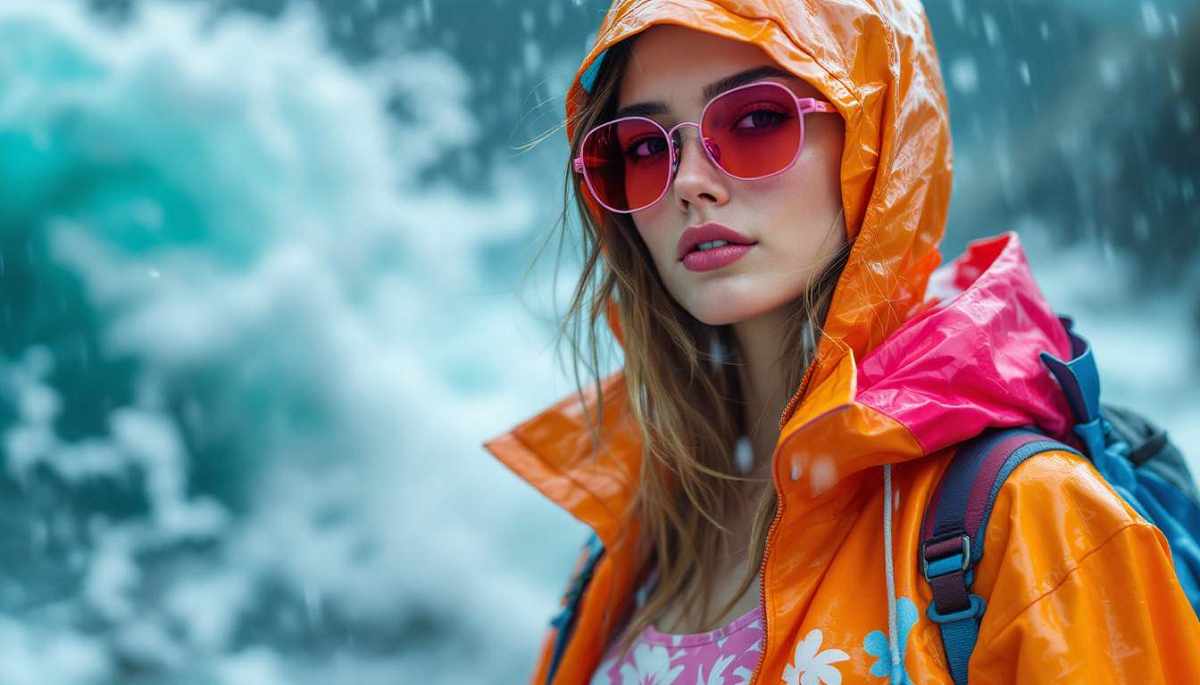Mode Von Taifun brings the raw, intense energy of storms into contemporary style. This unique trend blends bold, swirling designs, textures, and dramatic colors that reflect the unpredictable power of a typhoon. Pieces often feature fluid silhouettes and materials like waterproof fabrics, which not only convey the theme but also offer practicality. Shades of deep blue, stormy gray, and striking white are common, evoking the swirling clouds and churning seas associated with tropical storms. Accessories might mimic the movement of wind or rain, with dangling or flowing elements adding a sense of movement to each look. Typhoon-inspired fashion captures nature’s intensity, creating looks that are both daring and dynamic, perfect for those who want their style to make a powerful statement.
The Impact of Typhoons on Fashion Trends
Typhoons are powerful natural phenomena that not only impact the environment but also have significant influences on cultural aspects, including fashion. The devastation brought about by these storms often leads communities to rethink their clothing choices, prioritizing practicality and safety in their wardrobes.
In areas regularly affected by typhoons, the fashion industry adapts to the need for resilience. Designers are becoming increasingly aware of these environmental factors, leading to a shift in trends that mirror the realities of life in vulnerable regions. The urgency of preparing for severe weather events can dictate the materials and styles that become popular.
For instance, the rise of waterproof fabrics and wind-resistant designs has become a staple in the collections of many contemporary designers. Brands are now experimenting with innovative textiles that not only repel water but also provide breathability, ensuring comfort during humid conditions often associated with typhoons. Additionally, the use of bright colors and bold patterns has emerged as a form of psychological resilience, allowing individuals to express hope and positivity even in the face of adversity. This transformation in aesthetic choices reflects a deeper cultural shift, where functionality meets personal expression, creating a unique narrative that resonates with those living in typhoon-prone areas.
Moreover, the impact of typhoons on fashion extends beyond immediate clothing choices; it also influences the entire supply chain. Local artisans and craftspeople are increasingly sought after for their skills in creating durable, sustainable garments that can withstand harsh weather. This resurgence of traditional craftsmanship not only promotes local economies but also fosters a sense of community and shared identity among those affected by these natural disasters. As fashion continues to evolve in response to environmental challenges, it becomes a powerful medium for storytelling, allowing individuals to showcase their resilience and adaptability through their personal style choices.
Resilient Styles: Dressing for Extreme Weather
When faced with harsh weather conditions due to typhoons, practicality takes precedence over aesthetics. Resilient styles are characterized by their ability to withstand both the elements and the rigors of everyday life. Heavy-duty fabrics, water-resistant coatings, and adaptable designs are essential features of contemporary wardrobes in typhoon-prone areas.
Garments such as waterproof jackets, breathable yet insulated outerwear, and flexible footwear are increasingly favored. The focus is not solely on protection; style is still considered important. As a result, designers are creating pieces that offer both functionality and visual appeal, allowing individuals to express their personal style even amidst severe weather.
In addition to the core elements of resilience, layering has become a crucial technique in dressing for extreme weather. Layering not only provides warmth but also allows for versatility in adapting to fluctuating temperatures and conditions. For instance, a lightweight moisture-wicking base layer can be paired with an insulating mid-layer and topped with a waterproof shell. This approach not only enhances comfort but also enables wearers to mix and match colors and textures, making the outfit uniquely their own. Accessories, such as multifunctional scarves and hats that can be adjusted for warmth or breathability, further complement this layered look, ensuring that individuals remain stylish while braving the elements.
Moreover, sustainable fashion is gaining traction within the realm of resilient styles. As awareness of environmental issues rises, consumers are increasingly seeking out eco-friendly materials and ethically produced garments. Brands are responding by incorporating recycled fabrics and innovative materials that provide durability without compromising on sustainability. This shift not only addresses the immediate need for protective clothing but also aligns with a broader commitment to reducing the fashion industry’s carbon footprint. By choosing resilient styles that are both functional and environmentally conscious, individuals can navigate extreme weather while contributing to a more sustainable future.
Sustainable Fashion: Adapting to Nature’s Fury
In recent years, the sustainable fashion movement has gained momentum, particularly in regions susceptible to extreme weather. This shift reflects a growing awareness of the environmental impact of fashion and the need for eco-conscious choices. In the face of recurring typhoons, fashion brands are increasingly committed to sustainability.
Tools such as biodegradable materials, eco-friendly dyeing processes, and local sourcing of fabrics are becoming commonplace. This commitment to sustainability is not just about aesthetics; it serves as a vital source of resilience against the challenges posed by changing climates.
Moreover, the integration of innovative technologies is playing a crucial role in this evolution. Brands are now utilizing advanced techniques like 3D knitting and digital printing, which minimize waste and energy consumption. These methods not only reduce the carbon footprint of production but also allow for greater customization, enabling consumers to invest in pieces that truly reflect their personal style while being mindful of their environmental impact. This technological shift is paving the way for a more circular economy in fashion, where garments can be designed for longevity and recyclability, thus reducing the overall demand for new resources.
Additionally, the rise of second-hand and rental fashion platforms is reshaping consumer behavior. By promoting the idea that clothing can have multiple lives, these platforms encourage individuals to rethink their purchasing habits. Thrift stores and online marketplaces are becoming trendy, appealing to a younger demographic that values sustainability as much as style. This cultural shift not only helps to divert clothing from landfills but also fosters a sense of community among consumers who share a passion for sustainable living. As these trends continue to gain traction, the fashion industry is slowly but surely transforming into a more responsible and resilient entity, one that respects both the planet and its people.
Iconic Looks Inspired by Typhoon Culture
Fashion is a reflection of cultural identity, and the influence of typhoons can be seen in the unique styles that emerge from affected regions. Iconic looks often encompass elements that honor local traditions, materials, and survival strategies. Such styles can include vibrant colors symbolizing hope, practical structures allowing movement, and patterns inspired by natural phenomena.
Moreover, traditional garments may undergo modern adaptations to cater to contemporary tastes while retaining their cultural significance. These creations serve as a powerful reminder that fashion can emerge from adversity, and the unique narrative of each community enriches the global fashion landscape.
Preparing Your Wardrobe for Stormy Seasons
Preparation is essential for anyone living in a typhoon-prone area, and that includes having a well-thought-out wardrobe. This process involves selecting key pieces that can perform well during stormy seasons. Key items might include versatile layers, sturdy footwear, and accessories that can be multifunctional.
When curating a storm-ready wardrobe, it’s important to assess each item’s durability and practicality. For instance, investing in quality rain gear, quick-drying fabrics, and clothing with adequate ventilation can make all the difference in comfort and safety during severe weather.
The Role of Fashion in Disaster Preparedness
Fashion plays an invaluable role in disaster preparedness, particularly in typhoon-impacted regions. The choice of clothing can directly affect individuals’ safety and comfort during extreme weather events. Not only do certain styles provide protection from rain and wind, but they can also influence psychological resilience.
Clothing that is comfortable and functional can improve an individual’s sense of security and well-being during stressful times. Community initiatives often promote fashion that emphasizes both preparedness and style, with workshops focused on teaching individuals how to dress for extreme conditions effectively.
Fashion Designers Responding to Climate Change
Fashion designers around the world are increasingly acknowledging their responsibility toward climate change. In response to the escalating frequency of typhoons, many have begun to create collections specifically designed for those living in affected areas. Innovating with eco-friendly materials and sustainable practices, they are paving the way for a new era of adaptive fashion.
Some designers are incorporating smart technologies into clothing, allowing them to change based on weather conditions. These innovations not only offer protection but also showcase how fashion can evolve in tandem with climate realities, creating products that are as intelligent as they are stylish.
Typhoon-Inspired Accessories: Function Meets Style
Accessories are often the finishing touches that complete an outfit, and in the context of typhoon fashion, they serve as both functional and stylistic enhancements. Items like waterproof bags, durable hats, and versatile scarves have become essential as they protect against the elements while also offering stylish options for self-expression.
Many of these accessories are designed with bright colors and bold patterns that reflect the vibrancy of the culture and spirit of the communities they represent. As designers integrate functionality with aesthetic appeal, the result is a collection of accessories that not only withstand the forces of nature but also enrich personal style.
The Evolution of Rainwear: From Practical to Chic
Rainwear has undergone a significant transformation over the years. Once considered purely utilitarian, modern rain gear now combines haute couture elements with essential protective features. Designers are continually blurring the lines between practicality and chic, creating pieces that are as fashionable as they are effective against harsh weather.
With innovations in materials like breathable yet waterproof fabrics, fashion-forward rainwear can be seamlessly integrated into everyday outfits. This evolution reflects a broader trend within the fashion industry to establish clothing that meets both aesthetic desires and practical needs in the face of climate challenges.
Celebrating Local Artistry: Fashion in Typhoon-Prone Areas
The local artistry seen in fashion design within typhoon-prone areas is a testament to resilience and creativity. Local artisans often draw inspiration from their environments, using traditional techniques to create modern pieces that tell a story. Materials sourced from the local landscape add depth and context to each design.
By supporting local artistry, communities not only preserve cultural heritage but also foster economic resilience. This celebration of local design contributes to a fashion ecosystem that thrives on innovation while honoring the natural surroundings and the challenges posed by typhoons.










